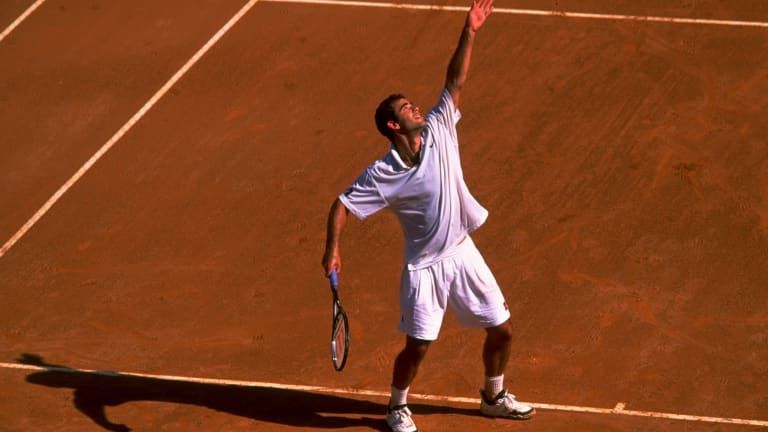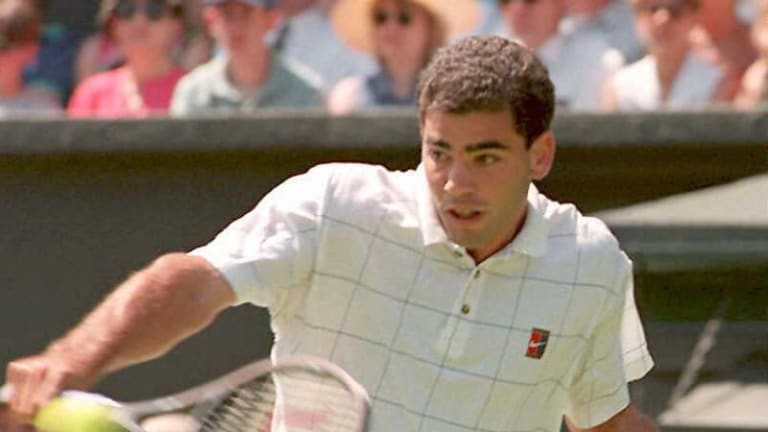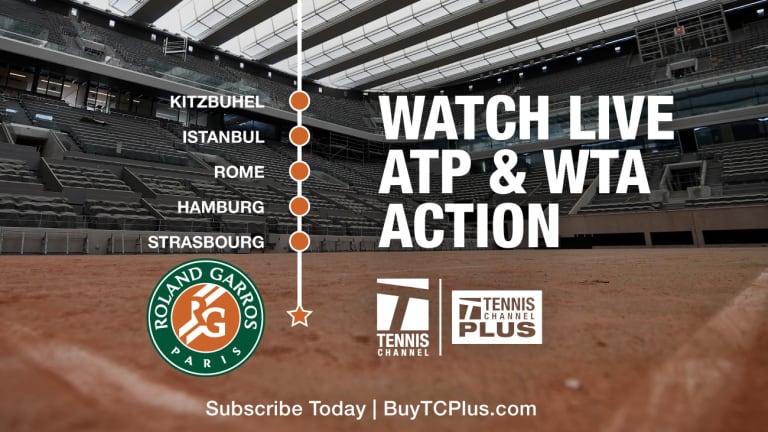At Pete Sampras' peak, was he the most unbeatable men's player of all?
Sep 18, 2020Frances Tiafoe joins Tommy Paul in reaching quarterfinals of Roland Garros for first time
By John Berkok Jun 01, 2025Top 5 Miami Finals, No. 3: Pete Sampras d. Gustavo Kuerten, 2000
By Steve Tignor Mar 25, 2024Pete Sampras asks for 'good thoughts and prayers' as he reveals wife Bridgette's ovarian cancer diagnosis
By Baseline Staff Oct 29, 2023The 10 closest calls for American men at the majors since Andy Roddick's 2003 US Open title
By Joel Drucker Sep 03, 2023Pete Sampras retired 20 years ago at the US Open—what did he leave behind?
By Joel Drucker Aug 25, 2023Novak Djokovic vs. Pete Sampras at Wimbledon: Who would win?
By Joel Drucker Jul 11, 2023My Tennis Life: Paul Annacone's pupil warms up with “two left shoes”
By Liya Davidov Jul 06, 202330 Years Ago: Pete Sampras rises to No. 1 on the ATP rankings for the first time
By John Berkok Apr 12, 2023The Sunshine Double: All the players who’ve won Indian Wells and Miami in the same year
By John Berkok Mar 26, 2023At Pete Sampras' peak, was he the most unbeatable men's player of all?
Steve Tignor and Joel Drucker discuss Steve Flink’s new book about the U.S. great, who has been overshadowed in the Big 3 era.
Published Sep 18, 2020
Advertising
This edition of The Rally discusses Steve Flink's new book, Pete Sampras: Greatness Revisited. You can order it from Amazon here, and get the author's perspective on the project here.
Hi Joel,
This morning I watched Coco Gauff struggle mightily with her serve in her loss to Garbiñe Muguruza in Rome—she finished with 15 double faults. At one point during that barrage of misses, Mary Carillo, commentating for Tennis Channel, said she wondered why more players don’t hire coaches for their specific weaknesses—a serve coach, a volley coach, a ground-stroke coach, etc.
Carillo’s words rung a bell right away, because earlier this week I had read about how a young Pete Sampras did just that. His main coach, Pete Fischer, who didn’t play the game well himself, brought in specialists to fine tune Sampras’ forehand, volley and serve. It seemed to have worked out well.
This was one of the nuggets I took from a new book on Pistol Pete, by our colleague, Steve Flink, called Pete Sampras: Greatness Revisited. At first glance, with the tours in Rome, this might seem like an odd week to talk about a fast-courter like Sampras. But as Flink reminds us, Sampras actually won the biggest clay-court title of his career at the Foro Italico, in 1994. Coached by another U.S. player who had won the Italian Open, Vitas Gerulaitis, Sampras rolled over Boris Becker in the final that year. Unfortunately, as we know, he could never repeat that performance in Paris.

At Pete Sampras' peak, was he the most unbeatable men's player of all?
© Getty Images
Advertising
Sampras serving at the Foro Italico, in 1999. (Getty Images)
But clay or no clay, this is an interesting time to read and talk about Sampras, and to be reminded of his accomplishments. As the “Greatness Revisited” in the title implies, that’s just what Flink’s book does. It’s a timely corrective, because among the game’s great men’s players, Sampras has been the one most overshadowed by the Big 3. Rod Laver has the Laver Cup. John McEnroe is a commentator. Boris Becker, Ivan Lendl and Stefan Edberg have returned as coaches. Jimmy Connors will always have the ’91 Open. Andre Agassi will always have his outfits and his wig. But Sampras has dropped away from the spotlight entirely. He was best known simply for his game, and for having won 14 major titles, the most among the men when he retired in 2002. Since then, he’s been passed not once, not twice, but three times, by Roger Federer, Rafael Nadal and Novak Djokovic.
Hence, Greatness Revisited, which patiently and clearly walks us through all of Sampras’s most important matches, from his 1988 debut to his US Open send-off in 2002. What I liked best was hearing this tale told directly by the players of that era. Flink talked extensively with Sampras, and also got the other side of the story from rivals like Lendl, Edberg, Agassi, McEnroe and Goran Ivanisevic. If you liked men’s tennis at the end of the serve-and-volley era, this book takes you inside its key moments.
At the start, Flink makes his pro-Sampras slant clear. “He won and lost as honorably as it could be done,” he writes. In the great Sampras-Agassi divide of the 1990s, I was solidly on Team Andre. But by the end of this book, after hearing so much from Sampras himself, I found myself agreeing with Flink’s assessment of Pete.
What did you think, Joel? Were you a Sampras fan, and what did you learn about him from Greatness Revisited?
Hi Steve,
Ah, we disagree. I far preferred Sampras’ net-rushing style to Agassi’s baseline game.
One likely major reason was that, like Sampras, I’d also grown up playing tennis in Southern California and was very familiar with many of the concepts that formed his game—perhaps most of all, the concept of playing attacking tennis. This tradition goes way back to the 1930s with Ellsworth Vines and was continued by such greats as Jack Kramer, Pancho Gonzales, Billie Jean King, Stan Smith and, of course, hundreds more of all skill levels. Sampras was following a well-worn path. And in his time, an era when baseliners had become increasingly proficient, to make it work, Sampras had to take that playing style to even higher levels.
What I liked most about Greatness Revisited was its wire-to-wire depth. An odd aspect of lots of tennis writing is that the authors of various pieces and books frequently trivialize or even overlook the nuances of how tennis is actually played. Writers that wax at length on batters, shooters and putters provide little understanding about the skill set of a particular tennis player. During the Sampras-Agassi years, for example, how many pieces did we read that hardly had a word to say about each man’s tennis but instead became an exercise in armchair psychology, tinted often by how each spoke? Though I’m fine with psychological exploration, I’d like to think it’s best to ground it in an understanding of the subject’s particular craft.
This is precisely what makes Greatness Revisited so engaging. Flink went to great length to dig into all aspects of Sampras’ game—be it his decision to switch to a one-handed backhand to his challenges after winning the 1990 US Open, to extensive details on various matches Sampras played not just at the majors, but at other events that greatly broaden the portrait. Best of all was that Flink got extensive thoughts on these topics from both Sampras and such peers as Michael Chang and Jim Courier, as well as longstanding Sampras coach Paul Annacone and many others.

At Pete Sampras' peak, was he the most unbeatable men's player of all?
© AFP via Getty Images
Advertising
Sampras, circa 1995, strikes a backhand at Wimbledon. (Getty Images)
The deep-dive approach reminds me of this phrase: history is read backwards, but life is lived forward. In retrospect, the resume of Sampras adds up quite nicely: 14 majors, six straight years ranked No. 1 in the world, a Hollywood-like ending. And then, as fate has it, we’ve had 15 years of greatness from not just one, but three guys who’ve won even more majors. So there’s Sampras, yet another plaque on the wall—lionized, but barely recognized.
But as this book shows, a journey doesn’t work that way. No success is pre-ordained. As devoted and focused as Sampras was his entire career, there were matters of health that intermittently surfaced. Though Agassi was his greatest rival, there were others too—Americans like Chang, Courier and Todd Martin; to formidable Europeans Stefan Edberg, Boris Becker, Michael Stich, Yevgeny Kafelnikov, Marat Safin; to Australians Mark Philippoussis, Patrick Rafter and Lleyton Hewitt. Each of these guys posed questions to Sampras. And just about every time, he came up with the answer. To read about in such detail really provides insights into what makes a champion. It’s a very human process.
As an Agassi fan, Steve, what aspects of Sampras’ game do you think so often gave him the upper hand in their bigger matches?
Joel,
“Don’t write the forehands and backhands.” I’m guessing that, like me, you’ve heard that piece of advice from other, more established tennis writers and editors. The translation being: Nobody cares about what actually happened on the court, it’s the personalities of the players that matter. I understand that idea, but also think it short-changes the sport itself. Tennis is about personality, yes, but it’s also about who did what with the ball, and why, during certain points. In Greatness Revisited, Flink shows that you can make “the forehands and backhands” very readable, even over nearly 400 pages.
Of course, there’s more here than just X’s and O’s. I liked learning that Sampras believes he got his “Spartan toughness” from his Greek mother. That Tracy Austin thought Pete Fischer’s serve and ground strokes strokes were laughably bad—like, the worst ever. That Fischer would come over to the Sampras house for dinner and tell an astonished, 14-year-old Pete that “your competition is going to be Laver,” while he sat and ate the meal his mom had made him and probably thought about the homework he had to do that night.
I liked how Sampras admitted that he and Jim Courier could never be as close after they became rivals for Slam titles, and that this was OK. I liked hearing that Sampras was especially happy for Goran Ivanisevic when he finally won Wimbledon in 2001, and relished the chance to congratulate him the next time he saw him. I liked hearing Sampras talk about the differences in the competitive philosophies between him and Pat Rafter. Rafter came from the traditional “play hard and have a beer afterward” school of Aussie thought, and wanted Sampras to act like one of the boys, but Sampras was too reserved to live his life that way.

At Pete Sampras' peak, was he the most unbeatable men's player of all?
© Getty Images for American Expres
Advertising
Pistol Pete remains a reserved tennis icon. (Getty Images)
Overall, Sampras come across the way Flink describes him at the start: As an honorably modest individual who gravitated to an individual sport, and who understood that he could only be himself, even if that didn’t make him a star. Sampras himself says there’s a certain mythic, pull-the-sword-out-of-the-stone quality to his life story. He was the ordinary kid, gifted with extraordinary powers.
To answer your question about watching Sampras as an Agassi fan: It’s amazing how well you get to know, and respect, and sometimes hate, the game of a player who regularly beats your favorite player. How many times did I roll my eyes or hang my head after Sampras rocketed an ace past Agassi to erase a hard-earned break point? Andre fans know better than anyone how brutal Sampras’ game was.
Which brings me to another, somewhat controversial point that Flink makes: He believes that Sampras, at his best, was better than anyone in tennis history—away from clay, of course. I have to say that I’ve always agreed with that. Sampras is not the greatest male player ever, because others have now accomplished more. But to me, with that serve, forehand and net game, he’s still the most unbeatable. As Lendl told Flink, “the ball just crumbled on your racquet” when you tried to return Sampras’ serve, and there was nothing anyone could about it. The best tennis I’ve ever seen is still his win over Agassi in the 1999 Wimbledon final. Federer, Nadal, Djokovic: I think the ball would have crumbled on all of their racquets that day.
Do you agree, Joel, and did this book make you think any differently about Sampras?
Steve,
That 1999 Wimbledon performance was indeed remarkable. Sampras said it was the best tennis he ever played, so who I am to disagree? Still, when it comes to the battles many wage around such topics as the best ever, GOAT and such, consider me a conscientious objector. I wrote about it earlier this summer and was glad I was able to take time to think through my thoughts on this subject.
Rather, I relish the chance to constantly explore tennis’ genius across time—and in most instances, that means reminding people who those folks even were. Per the Flink book title, let’s revisit greatness.
So whether it’s with Pancho Gonzales or Rod Laver, Martina Navratilova or Maureen Connolly, it’s fascinating to explore the nitty-gritty attributes that made the top player of a given era particularly great. The ascent of social media and blogging has provided extensive analysis of the Big Three, whether it’s from passionate fans that worship one of them, to teaching pros who break down their techniques.
As for Sampras, reading this book—and concurrently watching several clips on YouTube—gave me the chance to once again witness his incredible command of the court. Earlier this year, we created a series of stories about the underrated assets of several tennis legends. I wrote one on Sampras that focused on his movement. For all the attention given to his big serve, particularly late in his career, Sampras covered the court like a panther. Constantly, he was in the right place to strike the ball as powerfully as desired.
At Pete Sampras' peak, was he the most unbeatable men's player of all?
Advertising
To some degree, court speed is innate. One time I interviewed Sampras and we took a look at a brief clip of the pre-adolescent “Petey” dashing forward to hit the ball, complete with his big smile and seemingly oversized hat. “I motored around the court pretty well for a little kid,” said Sampras.
But of course when that was also wed to the training he got from his many coaches, Sampras became quite adept at smothering his opponents with offense off all sides. Watch the 1990 US Open and you’ll see Sampras in full flight—snapping off crisp forehands and backhands, angled volleys, aggressive transition shots, again and again and again. So in Sampras, we’re looking at a guy somewhat like Laver when it comes to bold ball-striking, and Gonzales in the serving department.
So this leads me to another way to evaluate many of the greats somewhat different than title tallies: Which legend would you want to play for your life? From many older players, Gonzales and Lew Hoad often surface. Then you’d also have to consider Connors. Among women, I’m going with Monica Seles. Of the Big 3, I’m thinking the candidate is Nadal. But Sampras too enters the picture. Time after time, in so many high stakes matches, he played inspired tennis. He is absolutely the kind of player I want going toe-to-toe with evil forces—supremely able to play winning tennis.
Certainly Sampras aced the performance and longevity requirements. Along with Nadal and Rosewall, he’s one of the only three men to have won majors in their teens, 20s and 30s. His ability to so frequently deliver the goods under pressure is yet another sparkling dimension. Amid the natural contemporary emphasis on the Big 3, it’s always worth exploring the legacy of such a titan.

At Pete Sampras' peak, was he the most unbeatable men's player of all?